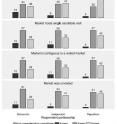New study: Are voters influenced by campaign visits?
Los Angeles, CA (August 17, 2016) Despite their extensive national press coverage, campaign visits might not be worth presidential candidates' time and resources. A new study out today finds that voters are largely unaware of and unresponsive to campaign visits. The study was published as part of a special issue of The ANNALS of the American Academy of Political and Social Science (a journal from SAGE Publishing) titled "Elections in America." "Of all the tools in a campaigns' strategic arsenal, the campaign visit is distinguished by its unchanging nature," wrote study author and campaign consultant Dr. Thomas Wood. "The observed pattern of visits within the swing states -- where the most politically pivotal markets were not more frequently visited -- suggests campaign consultants intend visits to affect the national media narrative rather than local coverage. Visits' effects on voters themselves, however, are much more modest than consultants often claim."
Wood looked at voter data to assess the impact of specific candidate visits during the 2012 presidential election. Comparing survey responses from 64,312 voters whose local TV channels aired the visits, did not air the visits, or did not air the visits but had access to non-local channels that did, Wood found:
In areas visited by both Romney and Ryan, 36% to 45% of respondents were unaware of the visits. In areas visited by either Romney or Ryan, 56% to 57% of respondents were unaware. The visits' impact did not spread to outside of the areas visited; awareness of the visits was similar for respondents who had not received local visits, even when they had access to local channels that aired the visits. Visits increased Democrat and Republican support for their parties' candidates by 2% to 3%, with this effect starting one day after the visit and ending by the third day after the visit. While Independents were 5% more likely to vote for Romney after the visits and were the only group affected by visits for longer than two days, Wood concluded that such a modest response would only matter in marginal elections.
Wood also found that the relationship between candidate visits and local media coverage to be modest, with no more than three extra stories from a visit than what would occur from general campaign coverage.
"Taken together, these findings invite a thought experiment: if visits have only a moderate impact on voters but consume vast amounts of the candidates' and their staff's time, attention, and resources, why not neglect visits and instead redouble candidates' attention to fundraising?," continued Wood. "New resources could then be spent on those activities that have been shown to more reliably influence voters--advertising, building out campaign infrastructure at the local level, and providing more resources for voter contact--and especially inspire turnout."
Source: SAGE
Articles on the same topic
- Study finds that views of swing voters do not matter much to presidential candidatesWed, 17 Aug 2016, 12:22:30 UTC
Other sources
- Views of swing voters do not matter much to presidential candidatesfrom Science BlogWed, 17 Aug 2016, 12:21:17 UTC
- New study: Are voters influenced by campaign visits?from PhysorgWed, 17 Aug 2016, 10:31:21 UTC
- Study finds that views of swing voters do not matter much to presidential candidatesfrom PhysorgWed, 17 Aug 2016, 10:31:20 UTC
